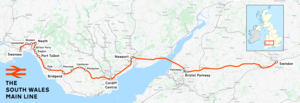
Back Prif Linell De Cymru Welsh South Wales Main Line German Línea Principal de Gales del Sur Spanish خط اصلی جنوب ولز Persian South Wales Main Line Dutch Южно-Уэльская главная линия Russian Güney Galler Ana Hattı Turkish 南威爾斯主線 Chinese
This article needs additional citations for verification. (December 2009) |
| South Wales Main Line | |||
|---|---|---|---|
 The entrance to the Chipping Sodbury Tunnel with the newly electrified overhead line equipment | |||
| Overview | |||
| Status | Operational | ||
| Owner | Network Rail | ||
| Locale | South Wales South West England | ||
| Stations | 18 | ||
| Service | |||
| Type | Heavy rail | ||
| System | National Rail | ||
| Operator(s) | Transport for Wales CrossCountry Great Western Railway | ||
| History | |||
| Opened | 1850 (Chepstow-Swansea) 1903 (Swindon-Patchway) | ||
| Technical | |||
| Line length | 84 miles 30 chains (135.79 km) | ||
| Number of tracks | Mainly double track, though quadruple track from Severn Tunnel Junction via Newport to Cardiff Central. | ||
| Character | Main line | ||
| Track gauge | 4 ft 8+1⁄2 in (1,435 mm) standard gauge | ||
| Electrification | 25 kV 50 Hz AC OHLE (Wootton Bassett to Cardiff Central) | ||
| Operating speed | Up to 125 mph (201 km/h) in England Up to 100 mph (161 km/h) in Wales | ||
| |||
The South Wales Main Line (Welsh: Prif Linell De Cymru), originally known as the London, Bristol and South Wales Direct Railway or simply as the Bristol and South Wales Direct Railway, is a branch of the Great Western Main Line in Great Britain. It diverges from the core London-Bristol line at Royal Wootton Bassett beyond Swindon, first calling at Bristol Parkway, after which the line continues through the Severn Tunnel into South Wales.
Much of the South Wales Main Line was built between the 1830s and 1886; originally trains to and from destinations in England ran via Chepstow, Gloucester and Stroud, joining the Great Western Main Line at Swindon. A more direct route was challenging yet desirable, leading to the construction of the line's most prominent civil engineering features, the Severn Tunnel. Completed in 1886, it permitted a significant reduction in journey times between various destinations, especially after the construction of the Badminton Line in 1903. During the British Rail era, the line was incorporated into the Western Region and steam locomotives were replaced by diesel locomotives, such as the Intercity 125 high speed trainsets. During the 2010s, the line between Swindon and Cardiff Central was electrified using the 25 kV AC overhead system as part of the wider electrification of the Great Western Main Line; this has permitted the operation of electric traction between Cardiff and London for the first time to commence in 2020.
Presently, Great Western Railway operates Class 800 trains between London and South Wales, and "Castle class" High Speed Trains on services between Cardiff and South West England. CrossCountry provides services from Cardiff to Nottingham via Severn Tunnel Junction and thence the Gloucester to Newport Line via Gloucester and Birmingham. Transport for Wales operates services between South Wales, and North Wales and the Midlands on the line. Operations are mostly managed from the Wales Rail Operating Centre in Cardiff; digital signalling is to be rolled out.
